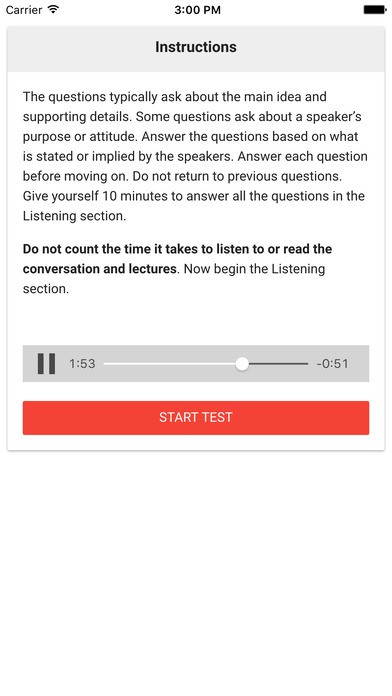
toefl listening practice tests app covered complete Listening Section with conversation and lecture types of sub section. It provides model Practice tests papers with detailed Solution.
Why TOEFL Listening Section is important in test?
TOEFL iBT Listening section is delivered immediately after the Reading section. The Listening section of TOEFL iBT measures your ability to understand spoken English in academic settings. In TOEFL iBT the listening is done for 3 major purposes:
1. Listening for basic comprehension.
2. Listening for pragmatic understanding.
3. To connect and combine ideas presented in multiple information sources.
Each part of the Listening section (2 or 3 parts) consists of 1 long conversation and two lectures. The test takers hear each lecture or conversation only once. Lectures and conversations are 3-5 minutes long. During the listening the time is not running. The allotted time of 10 minutes for each part is only for answering the questions.
TOEFL Listening Section Basics
The TOEFL Listening Section tests the ability to understand spoken English in an academic setting. Because lectures and conversations are the main forms of spoken English that university students must master for success, this section of the test gives students examples of lectures and conversations and tests their comprehension of them.
Students are tested on their ability to recognize a speakers purpose and attitude; identify the main idea and important points; recognize the way spoken information is organized; and draw inferences or conclusions from the lectures or conversations provided.
What is the Format in TOEFL Listening Section?
The Listening Section includes four to six lectures and two or three conversations. The lectures will take three to five minutes to listen to, and are each followed by six questions. The conversations will each take three minutes to listen to and are each followed by five questions. Only two conversations and four lectures will count toward the score. Extra lectures and conversations are included to evaluate material for possible use on future tests. The "experimental" questions are not marked as such, so every question must be treated as if it counts.
Lectures Type Topic
The lectures that test takers listen to in the Listening Section come in two forms. They could be primarily professor-led, where the professor does most of the talking, or they could be discussion-based where the professor encourages participation from the classroom and several people speak. There is usually a photo on the screen that indicates what type of lecture it will be. If the photo shows a picture of a professor at a podium, then the professor will be doing most of the talking for the lecture. If the photo shows several people sitting around a table, expect the lecture to be discussion-based and expect several different people to speak and share different points of view. Lectures could be on a range of academic topics from physical science to life science, social science or the arts.
Conversations Type Topic
The conversations in the Listening Section are divided into two types as well. All the conversations are types of conversation that might occur in a university setting, but some of the conversations are academic in nature, and others are conversations about university life outside the classroom.
These types of conversations might include a conversation with someone in the registrars office about paying a bill, a conversation with someone who works in the library, or a conversation with other students about a campus issue. A picture on the computer screen will help the test taker determine the type of conversation.



